Springboot源码分析之番外篇
摘要:
大家都知道注解是实现了java.lang.annotation.Annotation接口,眼见为实,耳听为虚,有时候眼见也不一定是真实的。
/**
* The common interface extended by all annotation types. Note that an
* interface that manually extends this one does <i>not</i> define
* an annotation type. Also note that this interface does not itself
* define an annotation type.
*
* More information about annotation types can be found in section 9.6 of
* <cite>The Java™ Language Specification</cite>.
*
* The {@link java.lang.reflect.AnnotatedElement} interface discusses
* compatibility concerns when evolving an annotation type from being
* non-repeatable to being repeatable.
*
* @author Josh Bloch
* @since 1.5
*/
元注解:
元注解 一般用于指定某个注解生命周期以及作用目标等信息。正如源码的注释一样,如果自定义的注解没有添加元注解就和平常的注释没有多大的区别,有了元注解就会让编译器将信息编译进字节码文件。
- @Target
@Target用于指明被修饰的注解最终可以作用的目标ElementType是一个枚举类型
ElementType.TYPE:类,接口(包括注释类型)或枚举声明
ElementType.FIELD:字段声明(包括枚举常量)
ElementType.METHOD:方法声明
ElementType.PARAMETER:正式参数声明
ElementType.CONSTRUCTOR:构造器声明
ElementType.LOCAL_VARIABLE:本地局部变量声明
ElementType.ANNOTATION_TYPE:注解声明
ElementType.PACKAGE:包声明
ElementType.TYPE_PARAMETER:类型参数声明 jdk1.8新增
ElementType.TYPE_USE:使用一种类型 jdk1.8新增
- @Retention
@Retention用于指明当前注解的生命周期RetentionPolicy是一个枚举类型
RetentionPolicy.SOURCE:编译器将丢弃注释。
RetentionPolicy.CLASS:注释将由编译器记录在类文件中,但在运行时不需要由VM保留。
RetentionPolicy.RUNTIME:注释将由编译器记录在类文件中并且在运行时由VM保留,因此可以反射性地读取它们。
- @Documented
@Documented 表示具有类型的注释将由javadoc记录和默认的类似工具。 这种类型应该用来注释注解影响注解使用的类型的声明客户的元素。 如果使用注解类型声明记录,其注解成为公共API的一部分注释元素。
- @Inherited
@Inherited 表示自动继承注解类型。 如果注解类型上存在继承的元注解声明,用户查询类的注解类型声明,类声明没有此类型的注解,然后将自动查询该类的超类注解类型。 将重复此过程,直到为此注解找到类型,或类层次结构的顶部(对象)到达了。 如果没有超类具有此类型的注解,那么查询将指示有问题的类没有这样的注解。请注意,如果带注解,则此元注解类型无效 type 用于注解除类之外的任何内容。 另请注意这个元注解只会导致注解被继承来自超类; 已实现的接口上的注解没有效果。
注解实现
- 如何自定义注解?
package com.github.dqqzj.springboot.annotation;
import org.springframework.core.annotation.AliasFor;
import org.springframework.stereotype.Component;
import org.springframework.stereotype.Service;
import java.lang.annotation.ElementType;
import java.lang.annotation.Retention;
import java.lang.annotation.RetentionPolicy;
import java.lang.annotation.Target;
/**
* @author qinzhongjian
* @date created in 2019-07-28 07:54
* @description: TODO
* @since JDK 1.8.0_212-b10
*/
@Target(value = {ElementType.TYPE})
@Retention(value = RetentionPolicy.RUNTIME)
@Component
public @interface Hello {
@AliasFor(
annotation = Component.class
)
String value() default "hi" ;
}
- 如何获取注解元素信息?
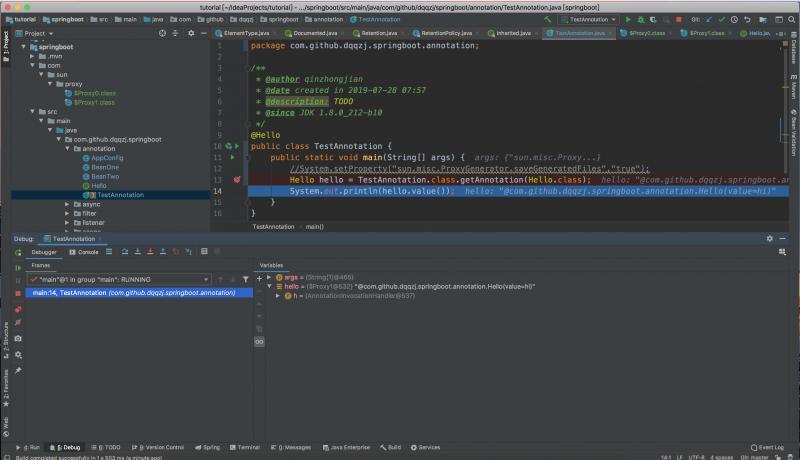
如上图所示注解其实也是使用了代理,而且是JDK代理的。
注解原理分析
既然是运行时生成的代理类,我们就可以在启动类上添加 System.setProperty("sun.misc.ProxyGenerator.saveGeneratedFiles","true") 或者
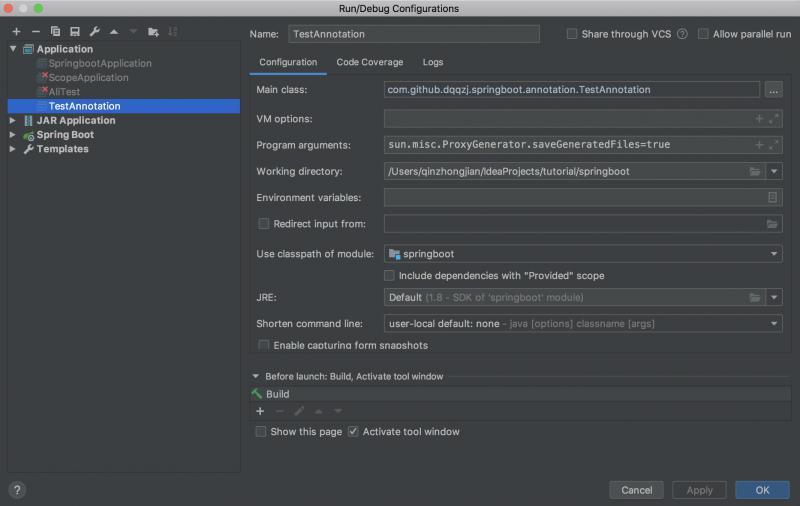
我们来分析一下生成的代理类
package com.sun.proxy;
import com.github.dqqzj.springboot.annotation.Hello;
import java.lang.reflect.InvocationHandler;
import java.lang.reflect.Method;
import java.lang.reflect.Proxy;
import java.lang.reflect.UndeclaredThrowableException;
public final class $Proxy1 extends Proxy implements Hello {
private static Method m1;
private static Method m2;
private static Method m4;
private static Method m0;
private static Method m3;
public $Proxy1(InvocationHandler var1) throws {
super(var1);
}
public final boolean equals(Object var1) throws {
try {
return (Boolean)super.h.invoke(this, m1, new Object[]{var1});
} catch (RuntimeException | Error var3) {
throw var3;
} catch (Throwable var4) {
throw new UndeclaredThrowableException(var4);
}
}
public final String toString() throws {
try {
return (String)super.h.invoke(this, m2, (Object[])null);
} catch (RuntimeException | Error var2) {
throw var2;
} catch (Throwable var3) {
throw new UndeclaredThrowableException(var3);
}
}
public final Class annotationType() throws {
try {
return (Class)super.h.invoke(this, m4, (Object[])null);
} catch (RuntimeException | Error var2) {
throw var2;
} catch (Throwable var3) {
throw new UndeclaredThrowableException(var3);
}
}
public final int hashCode() throws {
try {
return (Integer)super.h.invoke(this, m0, (Object[])null);
} catch (RuntimeException | Error var2) {
throw var2;
} catch (Throwable var3) {
throw new UndeclaredThrowableException(var3);
}
}
public final String value() throws {
try {
return (String)super.h.invoke(this, m3, (Object[])null);
} catch (RuntimeException | Error var2) {
throw var2;
} catch (Throwable var3) {
throw new UndeclaredThrowableException(var3);
}
}
static {
try {
m1 = Class.forName("java.lang.Object").getMethod("equals", Class.forName("java.lang.Object"));
m2 = Class.forName("java.lang.Object").getMethod("toString");
m4 = Class.forName("com.github.dqqzj.springboot.annotation.Hello").getMethod("annotationType");
m0 = Class.forName("java.lang.Object").getMethod("hashCode");
m3 = Class.forName("com.github.dqqzj.springboot.annotation.Hello").getMethod("value");
} catch (NoSuchMethodException var2) {
throw new NoSuchMethodError(var2.getMessage());
} catch (ClassNotFoundException var3) {
throw new NoClassDefFoundError(var3.getMessage());
}
}
}
这里的 InvocationHandler 实际上是我们的 AnnotationInvocationHandler ,这里有一个 memberValues ,它是一个 Map 键值对,键是我们注解属性名称,值就是该属性当初被赋上的值。接下来我调试代码给大家分享一下奥秘。
Hello hello = TestAnnotation.class.getAnnotation(Hello.class) 这个部分的调试代码我会忽略直接调试
AnnotationInvocationHandler 的相关方法。
注解奥秘的准备工作
- 反编译注解文件,发现注解确实是实现了
Annotation接口的
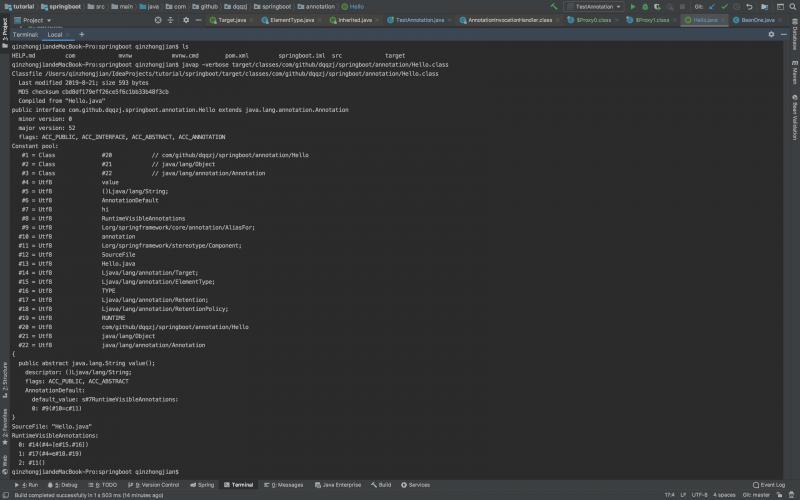
熟悉jdk规范的就会发现最底部的 s#7RuntimeVisibleAnnotations 这个是运行时可访问的注解信息,可供我们反射获取。
虚拟机规范定义了一系列和注解相关的属性表,无论是字段、方法或是类本身,如果被注解修饰了,就可以被写进字节码文件。属性表有以下几种:
RuntimeVisibleAnnotations:运行时可见的注解 RuntimeInVisibleAnnotations:运行时不可见的注解 RuntimeVisibleParameterAnnotations:运行时可见的方法参数注解 RuntimeInVisibleParameterAnnotations:运行时不可见的方法参数注解 AnnotationDefault:注解类元素的默认值`
注解奥秘调试
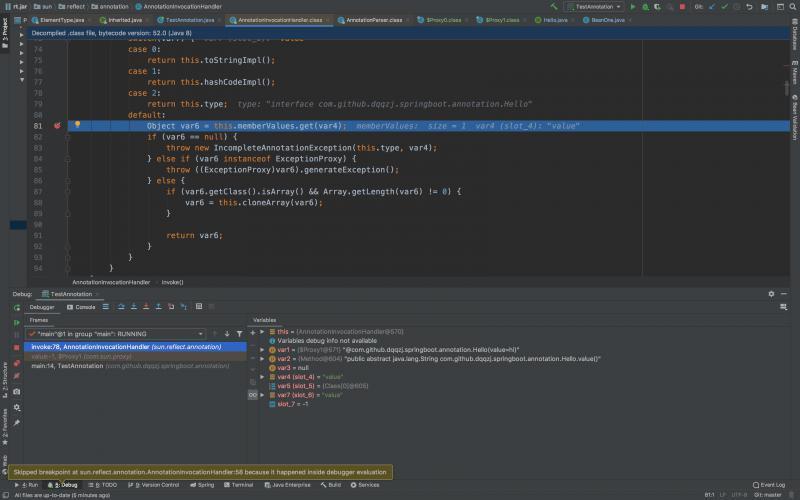
说明: 明明只有一个 @Hello 注解为什么左侧会出现2个代理类的原因就在这个地方,会多出一个代理类
public final class $Proxy0 extends Proxy implements Retention {
//省略无关代码.......
}
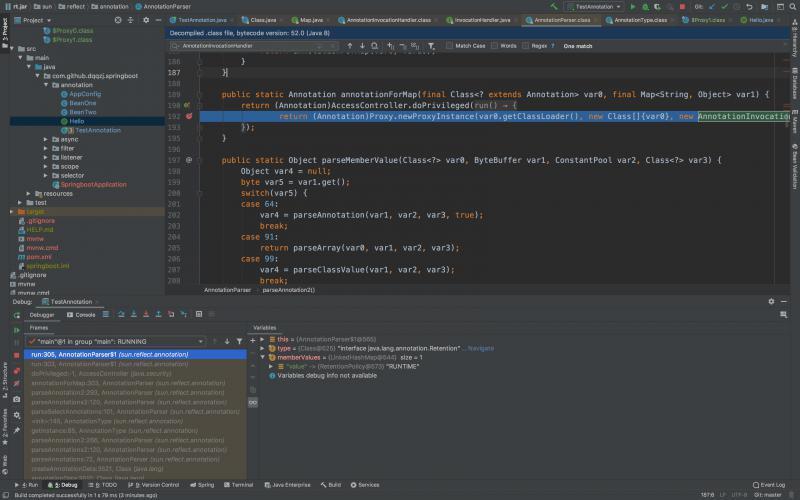

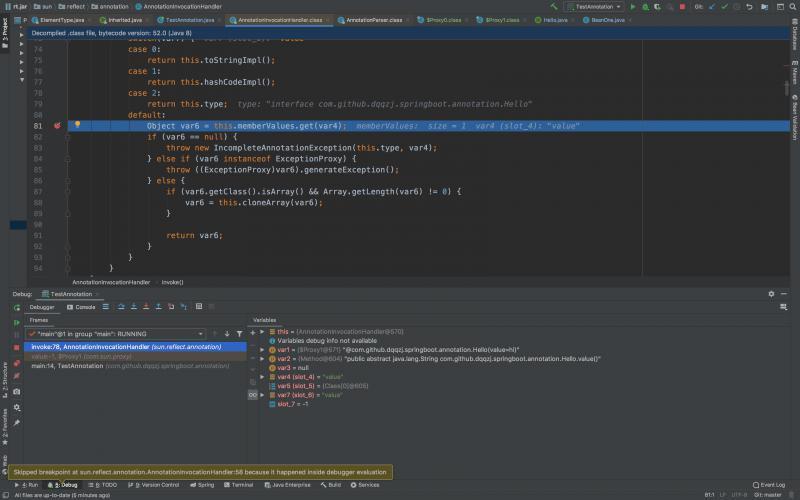
反射注解工作原理:
@Hello(value = "hi") RUNTIME
如何动态修改代理值?
我们已经知道了注解的值是存放在 Map<String, Object> memberValues 中的,那么我们就可以使用反射获取并重新赋值。
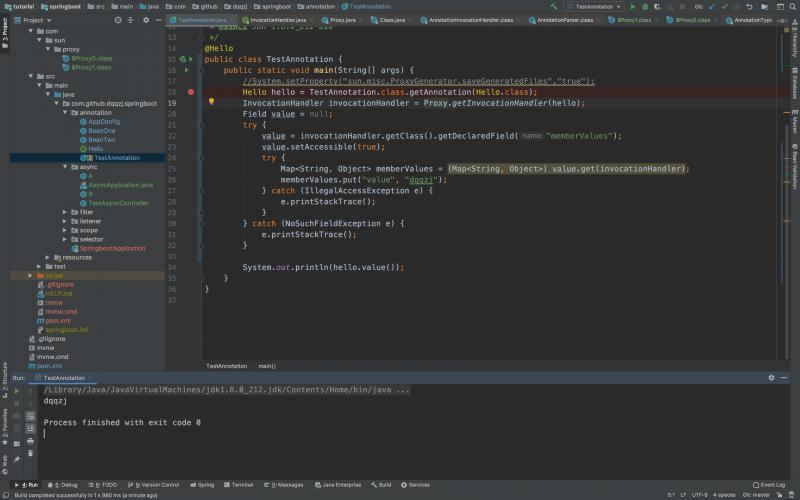











![[HBLOG]公众号](http://www.liuhaihua.cn/img/qrcode_gzh.jpg)

